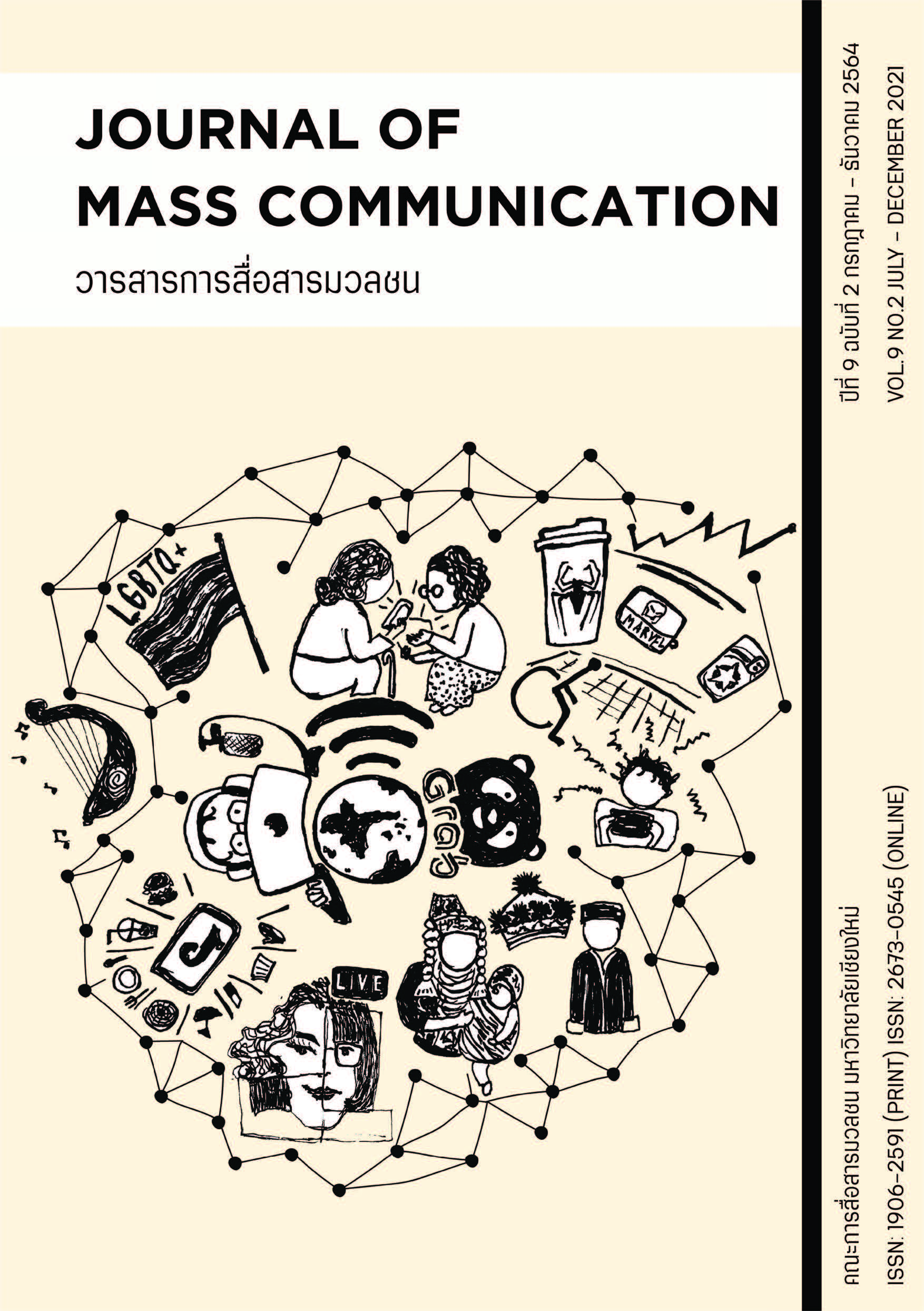คุณค่าข่าวในวารสารศาสตร์ดิจิทัลศตวรรษที่ 21
Main Article Content
บทคัดย่อ
บทความนี้เป็นงานศึกษาวิจัยเอกสาร นำข้อมูลที่ได้มาประมวลวิเคราะห์เพื่อตอบคำถามสำคัญที่ว่า ความเป็นข่าว การพิจารณาคุณค่าข่าว หรือ องค์ประกอบของข่าวเปลี่ยนไปอย่างไรในยุคสื่อข่าวดิจิทัลศตวรรษที่ 21 ทั้งนี้ วัตถุประสงค์เพื่อ 1) ศึกษาแนวทางการทำงานใหม่ ๆ ติดตามความก้าวหน้าและสถานการณ์การทำข่าว การพิจารณาคุณค่าข่าวและองค์ประกอบของข่าวให้เท่าทันการเปลี่ยนแปลง และ 2) เพื่อแสวงหาความรู้ด้านวารสารศาสตร์ในการพัฒนาสื่อการสอนสำหรับวารสารศาสตร์ในยุคดิจิทัล
ผลการศึกษาพบ 2 ประเด็นสำคัญ คือ ประการแรก เกณฑ์การพิจารณาคุณค่าข่าวในยุคสมัยใหม่ยังทับซ้อนกับเกณฑ์การพิจารณาคุณค่าข่าวแบบดั้งเดิมอยู่มาก แต่สิ่งที่ถกเถียงกันอย่างกว้างขวางคือลักษณะเฉพาะของผู้รับสารและคุณลักษณะของสื่อข่าวดิจิทัล ซึ่งส่งผลอย่างสำคัญกับ “กระบวนการได้มาซึ่งข่าว” และคุณภาพของงานข่าว-ภาพประกอบ รวมทั้งการนำลักษณะการเขียนข่าวที่เหมาะสมกับยุคสมัยใหม่มาเป็นส่วนหนึ่งในการพิจารณาคุณค่าข่าวด้วย ประการที่สอง ผู้ผลิตข่าวและองค์กรสื่อยังให้ความสำคัญกับ “เทคนิคเชิงการผลิต” มาประกอบการพิจารณาคุณค่าข่าว เพื่อใช้จัดระบบและกำหนดว่าจะรายงานหรือสืบข่าวต่อไปอย่างไร เกณฑ์พิจารณาความเป็นข่าวและให้คุณค่าข่าวเช่นนี้ถูกมองว่าเป็นตัวขับเคลื่อนหลักในกระบวนการผลิตข่าวที่มีอิทธิพลต่อการคัดสรรข่าว ขยายเรื่องราวและกำหนดการทำงานในห้องข่าว อย่างไรก็ตาม เทคโนโลยีดิจิทัลที่เปลี่ยนไป ทำให้เกิดเงื่อนไขประกอบการพิจารณาใหม่ ๆ เช่น การเกิดกลุ่ม “เนื้อหาแบบผู้ใช้สร้างขึ้น” (User-generated content- UGC) และการเกิดวารสารศาสตร์แบบมีส่วนร่วม (Participatory journalism) ประกอบกับอุปสรรคเรื่องการใช้ทรัพยากรและเวลาที่มีอย่างจำกัดมากขึ้น ตลอดจนอิทธิพลทางสังคม วัฒนธรรม การเมืองที่มีต่อนักข่าวโดยตรง ได้กลายเป็นเงื่อนไขสำคัญในการพิจารณาว่าอะไรควรจะเป็นข่าวมากขึ้น ในภูมิทัศน์สื่อใหม่นี้ ความมีค่าเป็นข่าวจึงกลายเป็นสิ่งที่แปรผันเคลื่อนไหวได้ไม่อยู่นิ่ง สิ่งสำคัญในปัจจุบัน คือ ผู้ที่พิจารณาคัดเลือกข่าวเพื่อนำเสนอข่าวควรให้ความสำคัญกับบริบทใหม่ดังกล่าว ใช้ประโยชน์จากความเปลี่ยนแปลงที่เกิดขึ้นในการเพิ่มคุณค่าข่าวและเพิ่มโอกาสในการเข้าถึงและเผยแพร่ข่าว ให้เป็นการเพิ่มพูนศักยภาพความเป็นสื่อข่าวมืออาชีพไปด้วยพร้อม ๆ กัน
Article Details

อนุญาตภายใต้เงื่อนไข Creative Commons Attribution-NonCommercial-NoDerivatives 4.0 International License.
ลิขสิทธ์ที่ผู้เขียนบทความต้องยอมรับ
เอกสารอ้างอิง
Bednarek, M., & Caple, H. (2014). Why do news values matter? Towards a new methodological framework
for analyzing news discourse in Critical Discourse Analysis and beyond. Discourse & Society 25 (2), 135– 158.
Bednarek, M., & Caple, H. (2017). The Discourse of News Values: How News Organizations Create
Newsworthiness. Oxford University Press.
Bell, A. (1991). The Language of News Media. Oxford: Blackwell.
Bradshaw, P. (2012). Model for a 21st Century Newsroom – Redux: How Digitisation has Changed News
Organizations in a Multiplatform World. Leanpub Book.
---------------. (2017). The Online Journalism Handbook: Skills to Survive and Thrive in the Digital Age. New
York: Routledge.
Brighton, P., & Foy, D. (2007). News Values. London: Sage.
Caple, H., & Bednarek, M. (2016). Rethinking news values: What a discursive approach can tell us about
the construction of news discourse and news photography. Journalism: Theory, Practice and Criticism, 17(4), 435– 455.
Caple, H., & Bednarek, M. (2016). Rethinking news values: What a discursive approach can tell us about
the construction of news discourse and news photography. Journalism: Theory, Practice and Criticism 17(4), 435– 455.
Fuller, J. (1996). News Values: Ideas for an Information Age. Chicago/ London: University of Chicago Press.
Galtung, J., & Ruge, M. (1965). The structure of foreign news: The presentation of the Congo, Cuba and
Cyprus crises in four Norwegian newspapers. Journal of Peace Research, 2(1), 64– 90.
Garcı´a-Perdomo, V., Salaverría, R., Kilgo, D.K., Harlow, S. (2017). To Share or Not to Share. Journalism
Studies, 19(8), 1180-1201.
Garrison, B. (1990). Professional news writing. Hillsdale: Lawrence Erlbaum Associates.
Gibbs, C. & Warhover, T. (2002). Getting the whole story: Reporting and writing the news. New York: The
Guilford Press.
Guo, Q. (2012). Perceptions of news value: A comparative research between China and the United States.
China Media Research 8(2), 26– 35.
Harcup, T., & O’Neill, D. (2001). What is news? Galtung and Ruge revisited. Journalism Studies, 2(2), 261– 280.
Harcup, T. & Neilll, Deirdre O. (2017). What is News? News values revisited (again). Journalism Studies,
18(12), 1470-1488.
Kilgo, D.K.., Lough, K., Riedl, M.J. (2017). Emotional appeals and news values as factors of shareworthiness
in Ice Bucket Challenge coverage. Digital Journalism, 8 (2), 267-286.
Lippmann, W. (1922). Public Opinion. New York: Free Press. (Reprint 1965.)
Masterton, M. (2005). Asian journalists seek values worth preserving. Asia Pacific Media Educator 16(6), 41– 48.
Palmer, J. (1998). News production, news values. In A. Briggs & P. Cobley (Eds.), The Media: An
Introduction (pp.377– 391). Harlow: Longman.
Papacharissi, Z., & Oliveira, M. D. F. (2012). Affective news and networked publics: The rhythms of news
storytelling on #Egypt’. Journal of Communication, 62, 266– 282.
Robie, D. (2006). “Four Worlds” news values: Media in transition in the South Pacific. Australian
Journalism Review, 28(1), 71– 88.
Rossler, P., Bomhoff, J., Haschke, J. F., Kersten, J., and Muller, R. (2011). Selection and impact of press
photography: An empirical study on the basis of photo news factors. Communications, 36, 415– 439.
Ryan, C. (1991). Prime time activism: Media strategies for grassroot organizing. Boston: South End Press.
Shoemaker, P.J. & Reese, S.D. (1996). Mediating the message: Theories of influence on mass media
content. New York: Longman Publishers.
Shoemaker, P. J., & Reese, S.D. (2014). Mediating the message in the 21st Century: A media sociology
perspective. New York: Routledge.
Trilling, D., Tolochko, P., Burscher, B. (2016). From Newsworthiness to Shareworthiness: How to predict
news sharing based on article characteristics. Journalism & Mass Communication Quarterly, 94 (1), 38-60.


